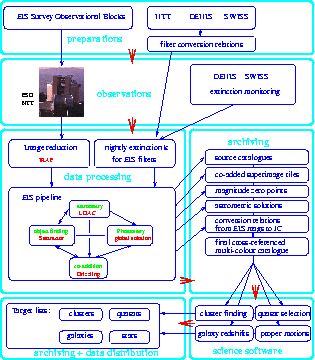 |
Next: System Interfaces to the STIS Calibration Pipeline
Up: Dataflow and Scheduling
Previous: Pipeline Calibration for STIS
Table of Contents -- Index -- PS reprint -- PDF reprint
R. N. Hook1, L. N. da Costa,
W. Freudling1 and A. Wicenec
European Southern Observatory,
Karl Schwarzschild Str-2, D-85748, Garching, Germany,
e-mail: rhook@eso.org, ldacosta@eso.org, wfreudli@eso.org, awicenec@eso.org
E. Bertin
Institute d'Astrophysique de Paris, 98bis Boulevard Arago,
75014 Paris, France,
e-mail: bertin@iap.fr
E. Deul
Sterrewacht Leiden, P.O. Box 9513, 2300 RA Leiden, The Netherlands,
e-mail: Erik.Deul@strw.LeidenUniv.nl
M. Nonino
Osservatorio Astronomico di Trieste, Via G.B. Tiepolo 11,
I-34131, Trieste, Italy, e-mail: nonino@ts.astro.it
1Space Telescope -- European Coordinating Facility
During the second half of 1997 and much of 1998 ESO is conducting a deep, multicolour imaging survey using the EMMI camera on the NTT. The ESO Imaging Survey (EIS, Renzini & da Costa 1997), will generate suitable statistical samples for a variety of astronomical applications, ranging from candidate objects at the outer edge of the Solar System all the way to galaxies and quasars at extremely high redshift. EIS data should provide a suitable database from which targets can be drawn for observations with the VLT, in its early phase of scientific operation (from the third quarter of 1998 to approximately the end of 2000). EIS has been conceived as a service to the ESO community and all the data will become public immediately after its completion.
In the initial (EIS Wide) phase of the project many exposures are being taken using a stepping pattern on the sky such that each step is about half of the frame size in both X and Y and on average each point is observed twice. This strategy allows accurate astrometric association between frames and gives an overlap pattern which shows clearly on Figure 3.
Figure 1 gives an overview of the data flow of the project starting with the preparation of ``observation blocks'' which are the basic unit of telescope execution and working through to the preparation and archiving of catalogues from the final coadded images.
There were four areas of software re-use (excluding subsequent science software):
Figure 2 gives an example of a subset of an output coadded EIS image. It
covers about 18 arcminutes and is the result of combining about 10 EMMI
images.
Figure 3 shows how the weights vary across this image. Image defects such as
dead columns and saturated regions show clearly as does the variation of
weight among the frames.
The primary aim of EIS is to provide data products, both images and derived catalogues, which will enhance the scientific returns from the forthcoming 8m telescopes, in particular the ESO VLT. An important secondary aim is to act as a test-bed for the VLT data flow concept, in particularly the observation preparation stage and the exploitation of the data within the Science Archive Research Environment. The software developed for EIS will act as the basis for a similar imaging survey to be conducted using the ESO 2.2m telescope with a large mosaiced CCD camera and may later also lead into a dedicated imaging survey telescope on Paranal with the ESO VLT.
Bertin, E. & Arnouts, S., 1996, Astronomy and Astrophysics Supplement, 117, 393
Epchtein, N., 1994, Astrophysics and Space Science, 217, 3.
Fruchter, A. S. & Hook, R. N., 1997, in Applications of Digital Image Processing XX, ed. A. Tescher, Proc. S.P.I.E. vol. 3164, 120
Hook, R. N. & Fruchter, A. S., 1997, in Astronomical Data Analysis Software and Systems VI, ASP Conf. Ser., Vol. 125, eds. Gareth Hunt and H. E. Payne (San Francisco, ASP), 147
Renzini, A. & da Costa, L. N., 1997, The Messenger, 87, 23
Next: System Interfaces to the STIS Calibration Pipeline
Up: Dataflow and Scheduling
Previous: Pipeline Calibration for STIS
Table of Contents -- Index -- PS reprint -- PDF reprint